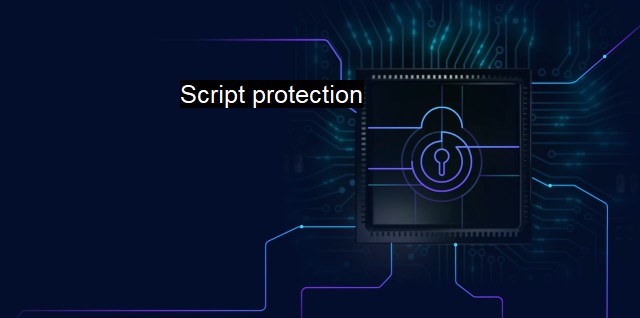What is Script protection?
Securing Your Data: The Importance of Script Protection in the Era of Digital Technology and Cybersecurity Threats
Digital technology has grown at an unprecedented rate. It has revolutionized the way we live, communicate and work. At the same time, however, this technology has also introduced numerous security threats, which have made data protection vital. Considering this, cybersecurity measures, have become vital for security-conscious businesses and organizations, which aim to keep their data safe from malicious actors.One of the primary concerns in terms of data protection is script protection. Script protection is a cybersecurity technique that helps in the safeguarding of your systems, data, and network against any types of harmful scripts or codes. These malicious scripts or codes generally come in the form of malware and use specific programming languages such as JavaScript to execute automated attacks.
The types of scripts largely depend on the type of attack that is being conducted. Harmful scripts can be used to unfurl viruses or initiate phishing attacks. As such, it is essential to ensure that these scripts are neutralized before they can wreak havoc. This is where script protection comes in.
The concept of script protection can be furthered explained by looking at web browsing and its associated functionality. Nowadays, web browsers offer a lot of functionalities which they derive from the installation of plugins or extensions. Scripting capabilities are at the forefront and key components of these plugins and extensions. It is almost impossible to find a plugin or extension that does not have a scripting component.
the availability of such extensions also means that they could serve as entry points for cyber-attacks. Cybercriminals understand this and have taken advantage of specific browser weaknesses in web protocols to execute successful attacks. Malicious attacks can range from code injections, JavaScript exploitation, and cross-site scripting techniques, among others.
In addition to browsers, malicious scripts can also infiltrate a system in numerous different ways, often entrenching themselves unnoticed and causing a great deal of destruction. in communications like email or SMS, when treated, equivalent levels of safeguards function as a safety valve, stopping malicious software files from executing.
Antivirus solutions help in preventing such security threats as they provide robust script protection functionality, limiting access to critical system resources which could be used to destabilize the system and introduce malicious software.
In addition to limiting access, antivirus solutions also play a critical role in monitoring a computer or network's activity and reporting any anomalous behavior which overlaps attacker behaviors resulting in the deploying of highly advanced threat prevention and script protection solutions.
Another important aspect of script protection is explaining data protection and maintaining privileged system resources. This includes maintaining specific permissions limits for certain users when executing functions that are necessary. Limiting access to these features provides critical security at the endpoint level, which plays an important role in minimizing system and network damage.
Beyond providing script protection, it is also necessary to ensure that all other aspects of running a cybersecurity-oriented organization are functioning correctly. Thus, in addition to improving script management, it is essential to monitor staff activities, password security practices, and help in boosting overall organizational security in every way possible.
In sum, Script protection offers essential protection for an organizational or company comprehensive data solution to guarantee ongoing security, playing a vital role in providing data protection against nefarious attackers. The cyber threat milieu is dynamic and very diverse with increased use of social engineering and phishing techniques. One unique characteristic of script protection is that regardless of technological advancements in the field of computer sciences, script protection will remain relevant as an important bulwark against unauthorized intrusions. Appropriate tools, consistent updates and testing of anti-virus and anti-malware software solutions provide in-depth defense capabilities appropriate for deploying from the cloud up to end-users, which is equally critical for a stellar, uninterrupted security posture.

Script protection FAQs
What is script protection?
Script protection is a cybersecurity measure that prevents malicious scripts from running on a system. It is typically implemented through antivirus software that identifies and blocks potentially harmful scripts before they can cause damage.Why is script protection important?
Script protection is important because many cyberattacks involve the use of malicious scripts. By blocking these scripts, organizations can prevent hackers from gaining access to sensitive data or causing damage to their systems.How does script protection work?
Script protection works by analyzing scripts to identify potentially harmful code. This can include things like attempts to execute commands, access sensitive files, or connect to remote servers. The antivirus software then blocks any scripts that exhibit suspicious behavior or contain known malware signatures.What are some best practices for implementing script protection?
Some best practices for implementing script protection include keeping antivirus software up to date, scanning all incoming files for malware, limiting the use of scripting languages in web applications, and minimizing the use of browser extensions that could potentially execute scripts without the user's knowledge. Additionally, it's important to educate employees about the risks of downloading or executing scripts from unknown sources.| | A | | | B | | | C | | | D | | | E | | | F | | | G | | | H | | | I | | | J | | | K | | | L | | | M | |
| | N | | | O | | | P | | | Q | | | R | | | S | | | T | | | U | | | V | | | W | | | X | | | Y | | | Z | |
| | 1 | | | 2 | | | 3 | | | 4 | | | 7 | | | 8 | | |||||||